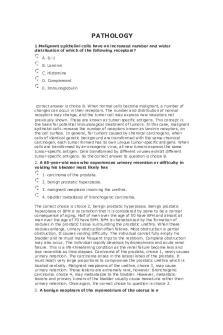Introduction to cellular pathology PDF

| Title | Introduction to cellular pathology |
|---|---|
| Course | Anatomy and Physiology |
| Institution | Keele University |
| Pages | 3 |
| File Size | 154 KB |
| File Type | |
| Total Downloads | 45 |
| Total Views | 131 |
Summary
Introduction to cellular pathology.docx...
Description
Introduction to cellular pathology
What is histopathology?
1.
Histopathology is a biomedical discipline concerned with producing accurate diagnostic information from patient tissue samples.
2.
Histopathology involves the study of very thin slices of diseased tissue under the microscope.
3.
Many diseases result in predicable or typical structural changes which a highly skilled pathologist can interpret. For example, the study of an excised mole to determine whether it is cancerous or not.
4.
Many different professionals work within the histopathology department including laboratory assistants, secretarial staff, biomedical scientists, and medically qualified pathologists.
5.
The goal of the department is to issue an accurate “report” containing diagnostic information to the referring clinician. The department also conducts post-mortem examinations.
Roles and responsibilities
1.
Laboratory Assistants – “Booking in” of specimens, ordering of supplies. Some perform more advanced tasks following training.
2.
Biomedical Scientists – Processing, embedding, sectioning and staining of specimens. Also have responsibility for quality control and quality assurance.
3.
NB: Further study permits biomedical scientists to perform more complex tasks such as cut-up, and reporting of certain specimen grades.
4.
Medically Qualified Pathologists – Initial cut-up, interpretation of slides (prepared above), dictating macroscopic and microscopic findings.
5.
Secretarial Staff - Entering of patients onto the LIMS, transcribing of macroscopic descriptions, etc.
Specimen collection, transport and receipt
1.
It is important that samples reach the histopathology department safely and in good condition (in later lectures we will consider the COSHH implications of some commonly used fixatives). On arrival, samples must be uniquely identified. The majority of samples come from the hospital in which the department is located. Additional samples may also be sent from GP surgeries or as referrals should the department have an expert in a particular field of pathology.
2.
3.
It is not uncommon for a histopathology department to process many thousands of specimens per week. Management (senior BioMeds) are responsible for ensuring that systems for receiving and moving specimens are safe and secure.
4.
Most histopathology samples are irreplaceable.
Sample to slide
Specimen types
Maintaining quality 1.
2
Clinical Pathology Accreditation is the UK accreditation body that assesses the QMS (quality management system)against a set of ISO (international organisation standards)standards. Laboratories are required to register with this body and agree to regular assessment visits (and even periodic surveillance visits).
3
2.
“Quality management ensures that all activities carried out are effective and efficient with respect to the system and performance…”The “business” of histopathology includes numerous steps, both manual and automated. Consider the journey a sample takes through a histopathology lab….Histopathology departments may appoint a “Quality Manager” – a Biomedical Scientist who is responsible for implementing a quality management system. The QMS comprises;
o
Quality Policy – ensuring a high quality standard is met
o
Quality Objectives
o
Quality Manual
o
Quality Control, Assessment, Improvement ,Document Control – ensuring standards have been met through checking all equipment or testing’s are accurate etc.
3.
EQA(external quality assessment) schemes compare the performance of one laboratory against others. Histopathology departments often subscribe to UKNEQAS which assesses cellular pathology and immunocytochemical techniques .Selective – lab selects some material for review by the scheme.Distributive – unstained sections sent from scheme to lab for various procedures. Results are analysed and the best scores and methods are shared amongst participants.Poor performance – three low scores triggers a local report and the offer of assistance. Substandard performance is reported and has to be declared to CPA(certified public accountant)....
Similar Free PDFs

intro to cellular process
- 34 Pages

Pathology
- 26 Pages

02. Cellular Responses to Injury
- 7 Pages

Introduction to
- 22 Pages

Introduction to Ninth Edition Introduction to
- 1,073 Pages

Anaphylaxis - Pathology
- 9 Pages

Oral pathology
- 15 Pages

Cardiovascular Pathology Table
- 21 Pages

Fundamentals of Pathology Pathoma
- 215 Pages

MCQs in Oral Pathology
- 171 Pages
Popular Institutions
- Tinajero National High School - Annex
- Politeknik Caltex Riau
- Yokohama City University
- SGT University
- University of Al-Qadisiyah
- Divine Word College of Vigan
- Techniek College Rotterdam
- Universidade de Santiago
- Universiti Teknologi MARA Cawangan Johor Kampus Pasir Gudang
- Poltekkes Kemenkes Yogyakarta
- Baguio City National High School
- Colegio san marcos
- preparatoria uno
- Centro de Bachillerato Tecnológico Industrial y de Servicios No. 107
- Dalian Maritime University
- Quang Trung Secondary School
- Colegio Tecnológico en Informática
- Corporación Regional de Educación Superior
- Grupo CEDVA
- Dar Al Uloom University
- Centro de Estudios Preuniversitarios de la Universidad Nacional de Ingeniería
- 上智大学
- Aakash International School, Nuna Majara
- San Felipe Neri Catholic School
- Kang Chiao International School - New Taipei City
- Misamis Occidental National High School
- Institución Educativa Escuela Normal Juan Ladrilleros
- Kolehiyo ng Pantukan
- Batanes State College
- Instituto Continental
- Sekolah Menengah Kejuruan Kesehatan Kaltara (Tarakan)
- Colegio de La Inmaculada Concepcion - Cebu





